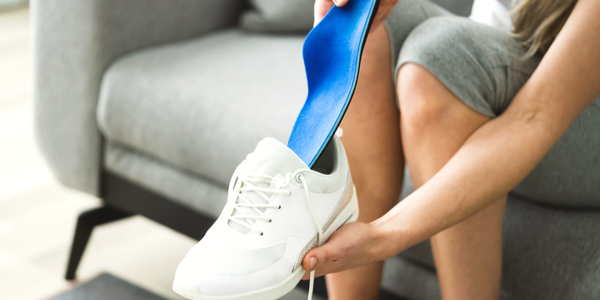
The curved underbelly of the foot, otherwise known as the arch, can cause pesky pain if not cared for correctly. Nowadays, shoes are often created for fashion rather than function, but this is not the case with arch support shoes.
Luckily, some smart researchers and creators understand the importance of foot support and established products to best support foot arches.
Keep reading to understand the science of foot support and learn what products help maintain active arches.
Why Is Arch Support Important?
The arch is not only the base of the foot, it is the foundation for the rest of the body! Its two basic functions include supporting body weight while standing and working alongside other bones, ligaments, and tendons to produce propulsion while moving. Thus, proper arch foot care relieves pressure elsewhere on the body and can help prevent injury.
In fact, not taking care of arches can cause misalignment and strain throughout the whole body and lead to back, ankle, knee, hip, pelvis, and posture issues. Many people just do not realize their odd hip or back pain is really a result of arch stress!
In short, healthy arches ensure optimal activity performance, promote positive posture, and help maintain central balance. They also lower injury risk in multiple body parts, but especially the knees and hips.
Types of Arches
Everything from arch height, width, and shape can differ from one person to another. Interestingly, all babies are born with flat feet until the arch begins to form shape during childhood, which is influenced by genetics, athletics, and previous injuries.
• Flat arches: Also known as fallen feet, people with flat feet tend to pronate (foot rolls inwards) and claims about arch support generally revolve around correcting posture and providing balance.
• Normal arches: People with normal arches need the least support of all types and can focus on strengthening the arch and surrounding musculature for the best care. Support claims tend to revolve around injury prevention and shock absorption for this population.
• High arches: Tall arched feet pronate the least and may even supinate (foot rolls outwards). Most claims suggest arch supports offer proper alignment and stability for these folks.
Science of Arch Support
Even though many pairs of shoes disregard arch support completely, those designed for specific athletic purposes such as running may not only regard them but also capitalize on their claims. Therefore, it is important to understand the true science behind arch support to make the most informed decision about shoes and foot supports like orthotics.
The main proposed benefits of arch support are:
• Help redistribute pressure
• Provide stability and balance
• Provide additional support
• Lessen or prevent pain
More specifically, a meta-analysis of more than 150 studies shines a light on the scientific basis of arch support. Researchers studied the most important claims related to arch support including injury prevention, running economy, cushioning, injury recovery, balance, and stability.
Injury Prevention
In terms of injury prevention, the studies generally concluded that arch-specific shoes or support do not significantly reduce the risk of lower limb injury. There was a slight decrease in risk of foot injury specifically, but not enough to report great influence.
Other findings determined injury risk was not high in new runners with different arch types using neutral running shoes and marine corp trainers given motion control, stability, and cushion shoes based on their foot type did not have less risk of injury.
Running Economy and Cushioning
Secondly, many shoes promise to improve athletic performance based on their ability to reduce the running economy. Running economy refers to the effort put into running or, in other words, the distance traveled and amount of energy consumed comparatively. The less energy consumed, the farther one can run and the better the economy.
Undoubtedly, barefoot runners possess the best-running economy, and conversely, people who use arch supports (especially when not tailored) have the worst running economy or slowest travel time.
Experts conclude that more the cushioning provided by arch supports reduces energy return towards movement similar to how a bouncy ball soars higher on concrete compared to grass.
Injury Treatment
Although arch support may not prevent injury well, laterally wedged foot orthoses are more efficacious in mitigating pain. Furthermore, arch supports that provide cushioning were deemed effective at lessening pain in the heel due to plantar fasciitis.
Because some arch supports lessen the load on the Achilles tendon, they may also reduce internal ankle rotation and eversion during walking and running, reducing the risk of sprains. The meta-analysis also determined that shock-absorbing insoles can relieve pressure on shins and better prevent shin splints.
Balance and Stability
Last but not least, researchers found a positive correlation between arch support and balance and stability among people with certain conditions or injuries. From the numerous studies, they concluded that orthotics known as vibrating soles showed improvement in balance and agility for athletes.
They did, however, emphasize that athletes without injuries or specific gate problems performed better without any arch support and/or in shoes that formed their natural foot shape.
The Best Arch Support
The best arch support is very individualized from person to person based on numerous factors including arch type, footbed type, material, previous and current injuries, walking/running gate, purpose, weight, and more. Moreover, arch supports vary in length, thickness, material, and specification.
Yet, almost all research suggests custom orthotics that are specifically molded to a person's arch and foot confer much more benefit than general over-the-counter orthotics that can potentially worsen conditions.
Guide to Four Different Types of Arch Support
• Orthotics (arch supports): The most popular of all the kinds, these inserts are rigid and stiff by design and boast various degrees of padding. They have reinforced arches to keep an individual's arch in the desired position and prevent body weight from collapsing the arches, which causes pain. People suffering from plantar fasciitis commonly recruit this kind of support.
• Arch cushions: For less severe arch problems, arch cushions may be more appropriate. Very similar to arch inserts in shape, they are less rigid due to foam padding material. These are also helpful for people who find arch inserts too painful and can be used to transition to arch support orthotics slowly.
• Cushion insoles: Designed for added comfort, these insoles provide arch padding and heel shock absorption. They provide solid support, promote better circulation (good for diabetics), and help keep feet cool in temperature. These can be very generalized and are already embedded in many shoes specifically made for walking, running, hiking, and trail running.
• Sports insoles: This type of arch support is specific to different sports or athletes such as long-distance runners and cyclists. Often, these are the most individualized and therefore the most expensive. They usually require the assistance of a foot specialist and orthotic engineer to ensure they are tailored with the performance of the sport in mind.
Conditions that Often Warrant Arch Support
• Plantar fasciitis
• Generalized arch pain
• Over-pronation
• Heel spurs
• Supination
• Morton's neuroma
• Running
• Cycling
The Final Word
Arch support is a rather complex topic. However, it is quite important because arches serve as the base of the human body and improper care can lead to pain in many more areas than just the foot.
Based on the research, people without injuries benefit most from strengthening the arch and surrounding muscles, tendons, and ligaments. Since arch support was not found to significantly prevent injuries, minimal is best.
Furthermore, most studies conclude arch inserts do not improve running economy/performance. They do, however, show some positive effects with balance, stability, and certain injury treatment such as plantar fasciitis, shin splints, and pronation.
Undoubtedly, arch support should be very individualized and tailored for specific uses. Seek the guidance of a professional as they come in many different shapes, sizes, and materials and have a wide array of uses.
References:
A Guide to Proper Arch Support. FootwearEtc. https://www.footwearetc.com/guide-to-proper-arch-support/?=.
Benefits of Arch Supports and Why You Should Wear Them. Lucky Feet Shoes. Published February 24, 2021. https://luckyfeetshoes.com/benefits-arch-supports/.
Sadi. The Truth About Arch Support - A Meta-Analysis of 150 Studies. Athletic Shoe Reviews. Published March 2, 2021. https://runrepeat.com/arch-support-study.





